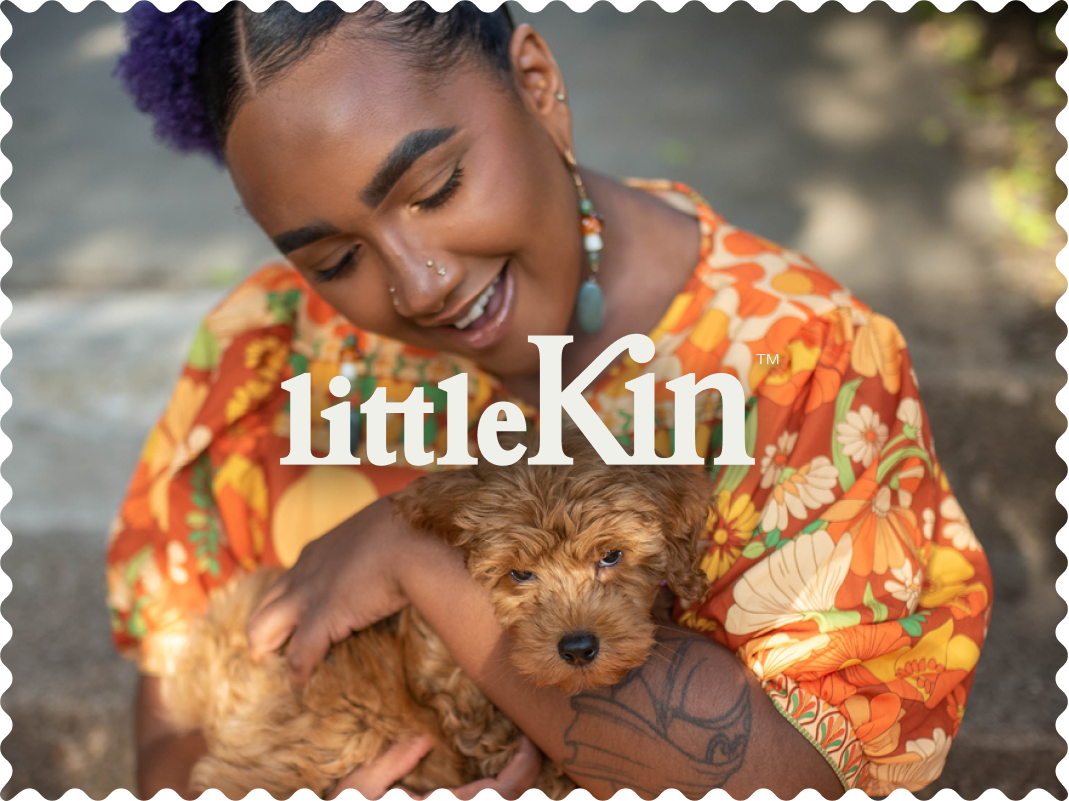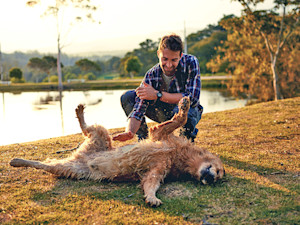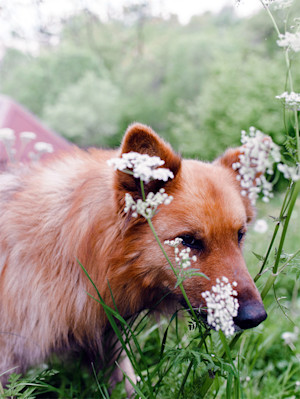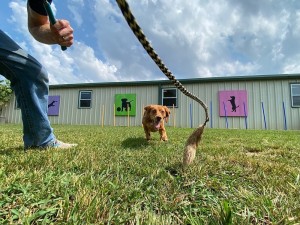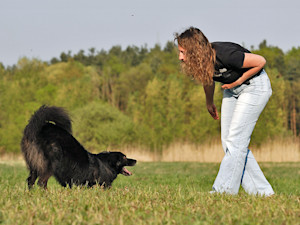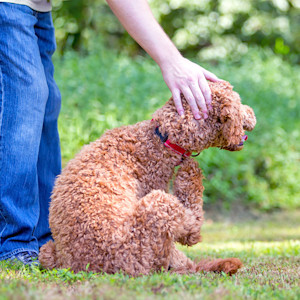
Share Article
In This Article:
Most Common Reasons Dogs Roll on Their Backs Should You Stop Your Dog from Rolling? How to Respond as a Pet Parent
Why do dogs roll on their backs? Is it a quirky canine yoga pose, a plea for belly rubs, or something more interesting? While it may seem like a simple, silly act, this behavior is rich with meaning and varies depending on context. From expressing trust to alleviating an itch, dogs have multiple reasons for flipping over.
Understanding this behavior requires an examination of canine body language and psychology. As Stephanie Gibeault, a canine behavior specialist based in Toronto, Canada, notes, “You may think your dog is rolling on their back for a belly rub, but the behavior is more complex than that.”
Most common reasons dogs roll on their backs
They feel comfortable and relaxed.
One of the most straightforward reasons dogs roll onto their backs is for comfort. Exposing their belly, which has less fur, helps them cool down, especially on warm days. This position allows dogs to regulate their body temperature by exposing their less-furred areas to cooler air.
How much do you spend on your pet per year?

It's also a vulnerable position, which dogs usually adopt when they feel safe and at ease in their environment. You may notice your dog doing this most often at home, stretched out on the carpet or their favorite sunny spot.
They’re engaging in social interaction and communication.
Rolling onto the back is often a social move. Dogs use body language to communicate, and this position can indicate trust, submission, or an invitation to play and romp around. It’s common during interactions with people and other dogs, especially when a pup feels safe, comfortable, and relaxed.
In dog-to-dog encounters, this move can defuse tension or signal playfulness. For humans, it’s a good reminder to read the rest of the dog’s body cues before going in for a belly rub.
It’s how they practice personal grooming and hygiene.
Rolling around is a practical way for dogs to use the ground to scratch hard-to-reach areas or rub off loose dirt, fur, or dander. It’s like a DIY spa treatment. This behavior helps them maintain a sense of cleanliness in their canine way, especially when a proper bath isn’t happening anytime soon.
They may even target specific textures, such as a rough rug or a gritty patch of grass, to hit the right spots. It’s part grooming, part bliss, and often looks silly, but gets the job done.
It’s how they play.
Sometimes rolling is good old-fashioned fun. Mid-play, dogs may throw themselves onto the ground and roll with excitement, wagging tails and goofy grins included. It adds variety to their play style and helps burn off excess energy. Whether playing with you, a squeaky toy, or imaginary friends, rolling is part of the comedy and the joy of being a dog.
You might see dogs use this move as a sneaky tactic to dodge or pounce during roughhousing. It’s part of their creative approach to staying active and entertained.
They like the feel of grass.
To dogs, grass is a sensory playground. The texture, temperature, and earthy scent make it feel amazing against their back. Rolling in it can be calming, refreshing, and satisfying, like nature’s massage table. Many dogs seek out soft, sunny patches where they can flop, wriggle, and soak up grassy goodness.
Some dogs develop favorite spots where the grass feels “just right.” It’s less about logic and more about living in the moment, which dogs excel at.
They are scratching or soothing their skin.
Rolling can be a form of relief when the skin feels itchy or irritated. If your dog has a minor rash, dry patch, or bug bite, the ground becomes a makeshift scratching post. While occasional rolling is normal, frequent or frantic rolling may signal allergies, fleas, or skin conditions. When comfort turns into obsessive behavior, take your pup to the vet.
Other concerns that may require a vet visit include excessive chewing, licking, or shaking. Rolling could offer temporary relief, but persistent irritation needs proper treatment, like special creams, shampoos, or medications.
They are getting rid of a scent.
Sometimes, dogs roll to get rid of a smell or pick up a new one. This primal behavior evolved from wild canines trying to camouflage their scent from prey or share interesting scents with the pack. Modern dogs may roll in something foul-smelling out of excitement, which is gross to us but instinctive to them. Welcome to the mysterious world of pup logic.
Some theories suggest scent-rolling helps dogs “report back” to their pack with fascinating finds. So, while it may smell horrible, your dog thinks they’re helpful, inclusive, and clever.
Should you stop your dog from rolling?
Most of the time, there’s no reason to stop your dog from rolling. It’s a natural behavior tied to comfort, play, and communication. However, if they’re doing it obsessively or continuously rolling in foul smells, it’s worth redirecting or investigating the cause.
When to be concerned
Rolling is usually harmless, but it can sometimes be a red flag. If your dog suddenly starts rolling more often or more aggressively than usual, it may indicate an issue that extends beyond simple playfulness. Skin allergies, fleas, mites, or dermatitis can cause intense discomfort, prompting dogs to roll frantically to self-soothe. You may also notice signs like redness, constant scratching, bald patches, or a foul odor from the skin.
Additionally, if your dog rolls while yelping, whimpering, or seems disoriented, it may indicate pain or neurological issues that require medical attention.
Another concern is if your dog becomes obsessed with rolling in a specific smelly substance. It could be driven by stress or compulsive behavior rather than instinct. Trust your gut. If your dog’s rolling looks more desperate than delightful, it’s time to schedule a vet visit to rule out any underlying health problems.
How to respond as a dog parent
Start by observing. Watch your dog’s body language when they roll. If it’s relaxed, joyful, and playful, that’s a great sign — they’re just enjoying themselves. Let them roll freely when it’s safe and appropriate. However, if they seem itchy, anxious, or repeatedly drawn to the same smelly or irritating spot, it could signal discomfort or a behavioral issue that needs attention.
To support your pup and redirect rolling when necessary:
Provide positive outlets. Offer toys, interactive games, textured mats, or safe outdoor spots where your dog can sniff and roll without concern.
Maintain good skin and coat health. Stick to a regular grooming routine and keep up with flea and tick prevention. Healthy skin is less likely to cause itchy or obsessive behavior.
Use gentle redirection. If your dog rolls indoors or in something unpleasant, calmly use verbal cues like “off” or “leave it,” paired with treats or distraction, not punishment.
Check the environment. Look for possible irritants such as lawn treatments, synthetic carpets, or household allergens that may trigger the need to roll.
Being proactive, observant, and consistent helps your dog stay comfortable while still engaging in the behaviors that bring them happiness.
Bottom line
Dogs roll on their backs for a variety of reasons, including comfort, play, social bonding, hygiene, itch relief, or just plain sensory pleasure. This behavior is instinctive and often shaped by individual personality. In most cases, it’s perfectly normal and even endearing. Still, like any quirky habit, it depends on context.
If rolling is accompanied by other symptoms such as excessive scratching, unusual odors, or anxious behavior, it may require further attention. Your role isn’t necessarily to stop the rolling, but to understand what’s behind it. Is your dog happily enjoying a roll in the grass, or are they trying to tell you that something feels off? When uncertain, trust your instincts and consult your veterinarian.
References:
Gibeault, Stephanie. “Why Does My Dog Roll on Their Back?” American Kennel Club, 25 July 2023, https://www.akc.org/expert-advice/lifestyle/why-does-my-dog-roll-on-their-back/opens in new tab
“Dog Behavior Tips.” King County Regional Animal Services, https://www.kingcounty.gov/~/media/depts/regional-animal-services/files/Guides-for-pets/DogBehaviorTips_RASKC.ashx?la=enopens in new tab
“Dog Body Language.” Loyola Marymount University Urban Ecology Lab, https://academics.lmu.edu/media/lmuacademics/cures/urbanecolab/module09/Dog%20Body%20Language.pdfopens in new tab
“Dog Body Language Basics.” University of Pennsylvania School of Veterinary Medicine, https://www.vet.upenn.edu/docs/default-source/ryan/ryan-behavior-medicine/dogbodylanguagebasics-(pdf).pdf?sfvrsn=335e17ba_2opens in new tab
“Dominance Position Statement.” Ohio State University Indoor Pet Initiative, https://indoorpet.osu.edu/sites/default/files/imce/Dominance_Position_Statement_download-10-3-14.pdfopens in new tab
“Operant Conditioning.” Introduction to Psychology Spring 2014, Penn State University, https://sites.psu.edu/intropsychsp14n3/tag/operant-conditioning/opens in new tab
“Operant Conditioning: How I Taught My Dog to Bark.” Introduction to Psychology Spring 2014, Penn State University, 7 Apr. 2014, https://sites.psu.edu/intropsychsp14n3/2014/04/07/operant-conditioning-how-i-taught-my-dog-to-bark/opens in new tab
“Trick or Treat? More Like Trick and Treat.” National Park Service, Denali National Park & Preserve, https://www.nps.gov/dena/blogs/trick-or-treat-more-like-trick-and-treat.htmopens in new tab
“What Does Your Dog’s Body Language Say About Them?” Wizard of Paws Blog, University of Wisconsin–Whitewater, 26 Feb. 2022, https://blogs.uww.edu/wizardofpaws/2022/02/26/what-does-your-dogs-body-language-say-about-them-2/opens in new tab

Valerie Mellema
Valerie Mellema has a Bachelor of Science in Agribusiness and Equine Industry from West Texas A&M University. She has been a professional writer for the past 20 years, covering a wide variety of pet health and care topics before founding a nonprofit focused on mental health in children and thoroughbred aftercare. She has four Border Collies and eight retired racehorses.
Related articles
Why Does My Dog Sleep on Their Back?
It is so sweet...
![Ginger dog in high green grass with white flowers.]()
How to Tell If Your Dog Has a Tick
Ticks (literally) suck. Keep an eye out for them on your pup.
![Golden Retrieve dog running in the grass outside, playfully chasing a flirt pole held by a man in blue jeans]()
How to Tell if Your Dog Is Bored
Get out the toys and puzzles.
![person playing tug with dog]()
The Do’s and Don’ts of Playing with Your Dog
Chase? Wrestle? Tug-o-war? Find out which are fair game.
![a dog doing a play bow with their human parent]()
6 Ways Your Dog Is Signaling They Want to Play—Right Now
Your dog knows when they want fun and games, but it’s important you understand. Here’s why.
![Poodle dog scratching an itch outside in the grass.]()
3 Reasons Why Your Dog Is Itching So Much
A little bit of itching? Totally normal. However, excessive scratching requires a diagnosis.
